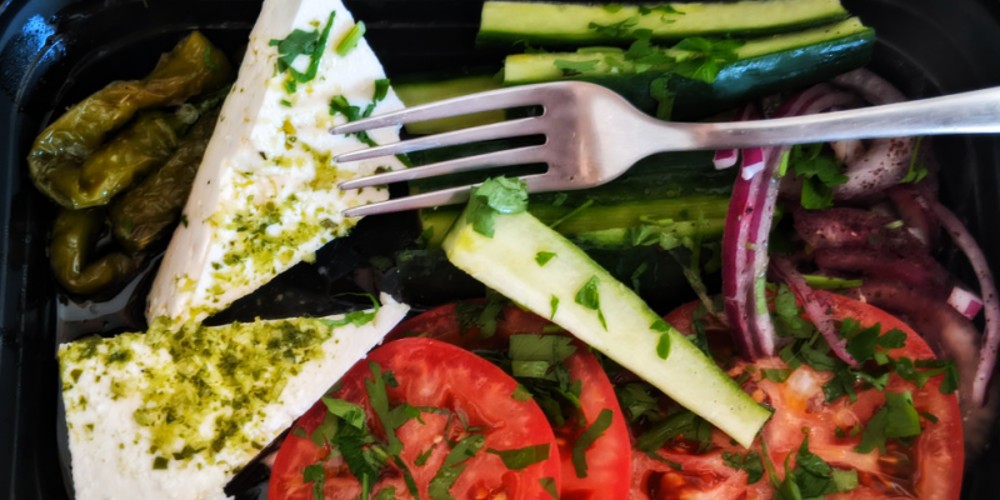As a lot of you know, I’ve been living in Europe for the past six months. But not “fancy” Europe. No Paris, no London, no Berlin, no Milan. Instead, I’m sticking to the less expensive and many would argue, less sophisticated Balkan countries. I’ve learned a lot from this research-heavy trip and one thing that particularly applies to preparedness is traditional food.
Sure, they’ve got modern bistros in Sofia and spicy Thai bowls in Bucharest, but my goal is not to be “fancy” – it’s to eat what local folks eat. So I focus on traditional restaurants, farmer’s markets, bakeries, and the like to stay fed. And if you pay attention when you do this, there’s a lot you can learn from traditional diets.
I always lose weight when I spend time in Europe. Part of it is probably due to the walking – I don’t have a car here, and my feet are my transportation. But the other part is the healthy, balanced local cuisine that isn’t soaked in glyphosate or tainted with genetic science. I notice an immediate difference in how my joints feel and in my energy levels. And this is all without restricting food or cutting out entire dietary groups. It’s simply eating normal food like a normal person.
Let me be perfectly clear: I’m not suggesting you need to slave for hours in the kitchen over every single meal. A lot of these things are not particularly labor intensive, and there are always shortcuts you can take while maintaining the level of nutrition that is just a part of traditional food.
Here are a few observations. These probably aren’t earth-shattering, but I hope you find them of interest.
Preserved produce is part of many meals.
In Bulgaria, a meal is not complete without a smokey dollop of lutenitsa. This is a sauce that is predominantly made from red peppers and also contains tomato, eggplant, onion, and carrot. The veggies are grilled or roasted then pureed into a sauce that is used as a condiment for meat and french fries and is also spread on a piece of fresh, warm crusty bread. It also plays a starring role in meat and cheese platters. You can make it fresh each time, or make a huge batch and pressure bath can it for some tasty vitamin C in the winter. (A lot of sites will tell you that it’s ok to water bath can this – I wouldn’t. The eggplant and peppers are too low-acid to be safely processed in a water bath.) There’s a very similar sauce to this in Bosnia and Serbia called ajvar, which does not have tomatoes and eggplant in it.
Important: Our sponsors at Jase are now offering emergency preparedness subscription medications on top of the long-term storage antibiotics they offer. Use promo code “Rucker10” at checkout!
In Romania, it seems that a meal is not complete unless it contains pickles – or muraturi. It’s a catch-all word that could land any number of pickled items on your plate. Often it’s the green cucumber pickles we’re familiar with when titling an item a pickle, but it could just as easily be beets, cabbage, or even a mix of veggies that have been brined. I’ve even seen menus with what translates to “pickle salad” – and this is simply a bowl of pickles of some description. What we’d consider pickles in America are called specifically pickled cucumbers. Here’s a traditional Transylvanian pickle recipe. and here’s a video about pickling veggies. I was never a fan of pickles until having the Romanian ones, and maybe I’ve just been Stockholmed into liking them.
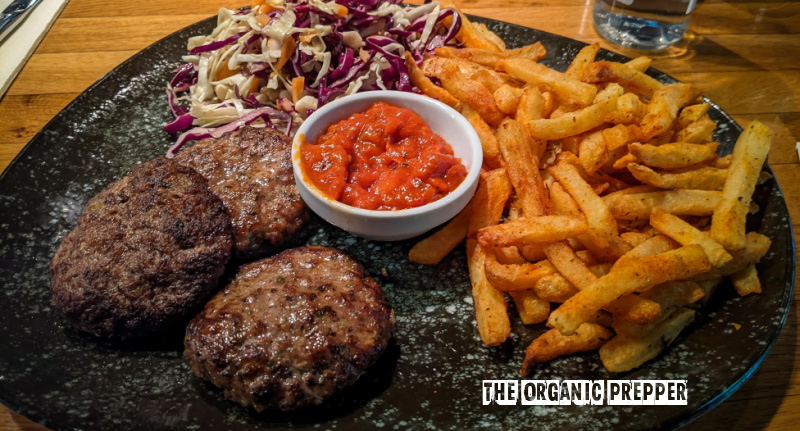
Carbs are king.
Folks in this part of the world are NOT afraid of carbs. If you said that you ate low-carb here they would look at you with confusion and offer you another potato. There is not a meal in sight in a traditional restaurant that doesn’t have at least one filling, delicious carbohydrate.
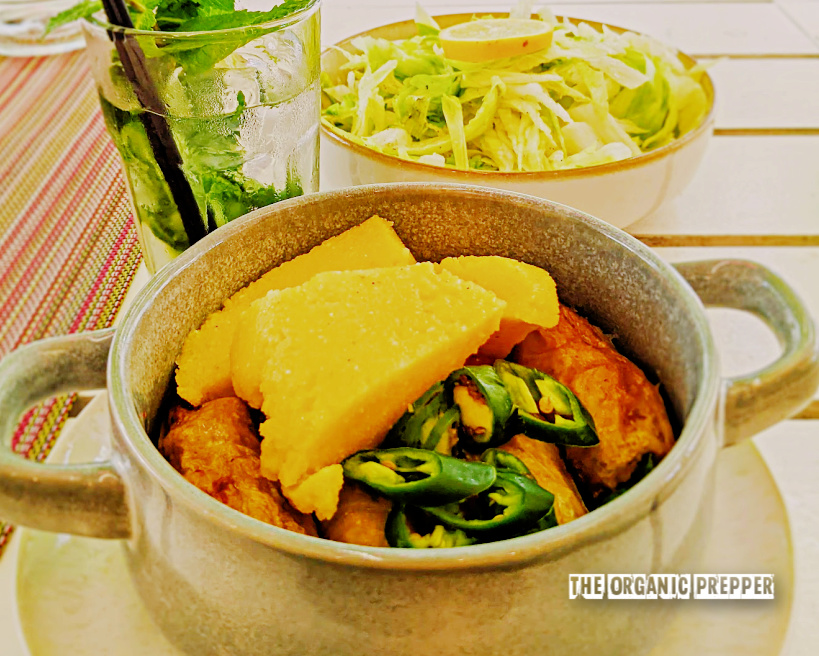
I went to a roadside tavern in Transylvania and ordered a meal that contained smoked meat, cheese, potatoes, AND polenta. It was baked in a clay dish and served as hot as the surface of the sun. There was a side of bread and butter, and of course, a bowl of pickles. It fueled me through a long afternoon of climbing ten billion steep tiny steps while touring a medieval castle and was absolutely delicious.
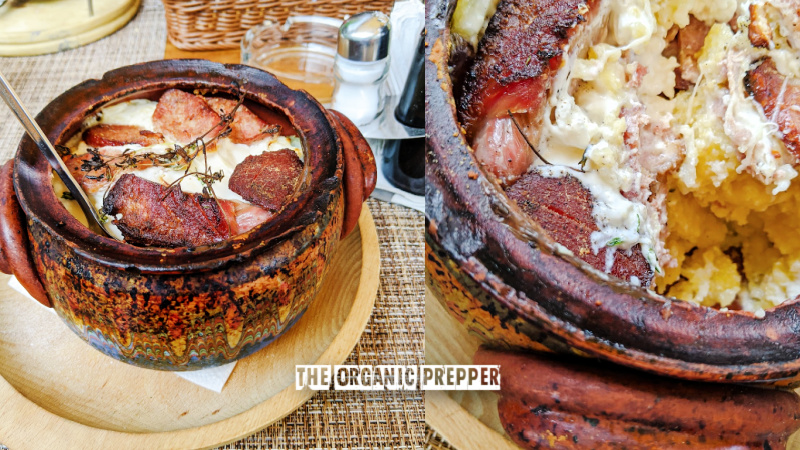
But there’s more to carbs than just giving you energy. They’re cheap and filling, and during difficult times this is more important than ever. As well, if times are tough, there’s a very good chance you’ll be doing a whole lot more physical activity and you’ll need that energy.
You may be thinking, “Carbs are the devil,” or “I’m diabetic, you idiot!” Well if you feel strongly about it, you don’t have to eat them. If you have a health contraindication, you shouldn’t eat them. But be sure you are cutting them out for the right reasons. Whole food should not be scary, and this is a very American way of looking at nutrition.
Dairy is delicious.
I don’t do a whole lot of dairy in the US. I eat occasional cheese because it’s CHEESE, but I use oat milk in my coffee and can’t even remember the last time I had a glass of milk as a beverage.
On my travels, however, avoiding dairy is no easy option. If you asked for oat milk at the cafe they’d look at you in confusion and probably bring you a bowl of oatmeal with milk. You can get a whole lot of different kinds of dairy milk at the grocery store, however, that aren’t always available in the US. Cow’s milk at various levels of pasteurization. Goat’s milk. Sheep milk. If you want a kind of milk, you can generally find it. What they don’t have is half-and-half and other concoctions like that. You can get your milk at 05, 1.5%, or 3.7%.
It’s used liberally in food too. Decadent creamy sauces, rich risotto, velvety polenta, and smooth whipped potatoes are served with nearly every meal. And don’t forget the cheese. Brined cheese, in particular, is very popular, and they don’t skimp on it. If you get a salad that has cheese, you get big whopping slices of it, an amount that I’d normally get for an entire week of Greek salads back home in one delicious dish.
But that isn’t all. Yogurt, sour cream, and kefir were all developed as ways to get a little more life from your dairy products. Cheese in brine can last for up to a year in a barrel in your cold room. Finding ways to use these products will add richness and flavor to your menus, even in hard times.
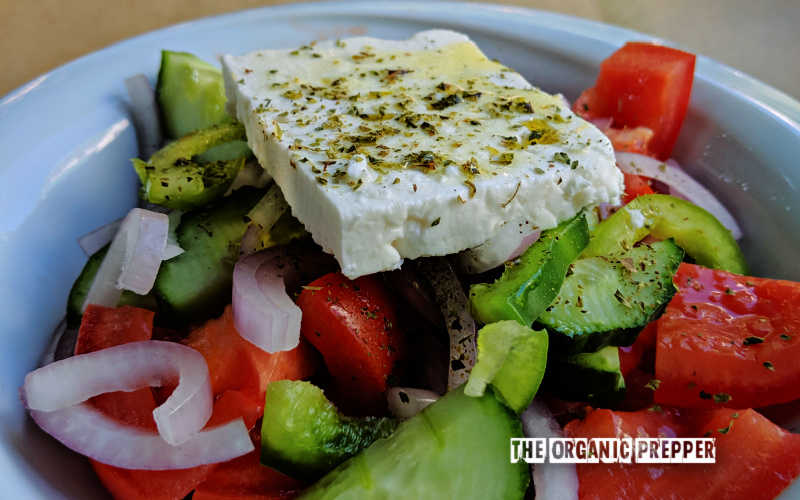
Bread really IS the staff of life.
It’s pretty rare to have a meal here that isn’t served with fresh, delicious bread. The great thing about bread is that it’s filling and provides you with energy, much like our discussion of carbs above. It’s inexpensive, particularly if you’re making it yourself.
And that’s another thing. When I say bread, I’m not talking about those icky cellophane bags from the grocery store shelf. I’m talking about bread that will actually mold in 3 days, and believe me, that’s the kind you want. It shows that every single iota of nutrition hasn’t been filtered out by a processing plant. They sell that kind of bread, but it very clearly says on the label, “TOAST” because Europeans don’t believe it’s fit for any other purpose.
You can make a dish of soup or stew go a whole lot further if you put a rustic loaf of bread on the table with it, and people will look at the meal in a completely different way with this simple addition. So, not only is it filling – it’s also the difference between something that seems sparse and something that makes people excited to sit down for the meal.
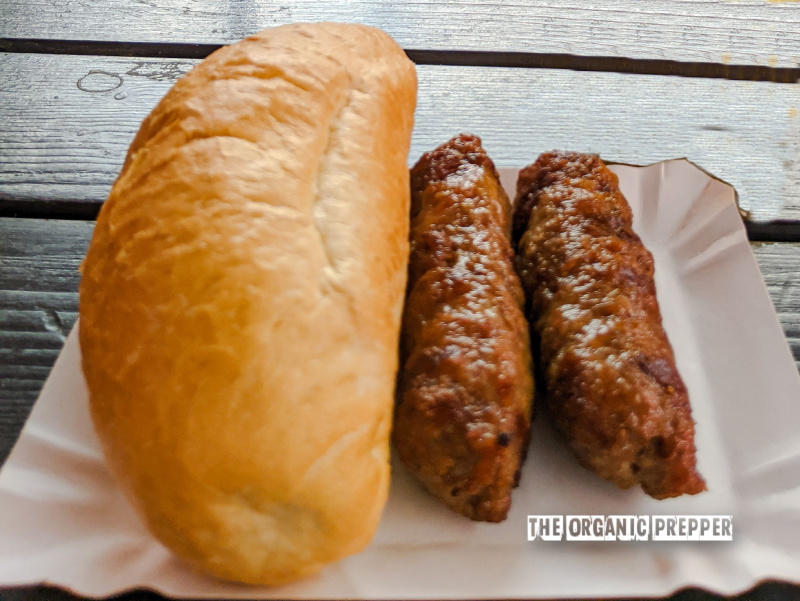
Sip on this.
How do you spot the American in the restaurant?
They’ve got a soda pop in front of them.
Sure, these countries have Coca-Cola and local sodas available, but most commonly, local folks drink the following:
- Water (still or sparkling)
- Coffee/tea
- Beer
- Wine
Going back in time, aside from the sparkling water, these are pretty traditional drinks. As a prepper, these are drinks you can acquire, store, or make. And if you stop buying fruity drinks and soda pop, your screaming grocery budget will thank you.
Simple is better.
When the ingredients are high-quality and best of all, fresh, you don’t NEED to be fancy. They’ll speak for themselves. Maybe add a few seasonings like herbs or sliced jalapenos, but you don’t need tons of added “stuff” or dips. Salad dressing is, most of the time, oil and vinegar that you put on yourself at the table. I was a bit confused as to why all my salads were dry until I realized this. Some salads don’t even need dressing due to the fresh and fabulous ingredients.
I’ve never eaten so much fresh parsley and oregano in my entire life. Back home, we use it mostly as a little garnish, but here it’s chopped up and used liberally to add freshness to a dish.
You can order a bowl of strawberries at a restaurant, and they’re just plain, delicious sliced berries with no syrup or whipped cream. Fresh sliced veggies have chopped herbs and a drizzle of high-quality olive oil. Carbs are topped with butter and black pepper.
If your food is good enough, it can stand on its own. Meals don’t need to be five courses of fancy. A delicious main dish and simple buttered potatoes with a side of fresh veggies is filling and delicious. And there’s nary a Lipton Sidekicks saucy pasta or rice in sight. There aren’t any additives. It’s like stuff your Grandma would’ve served your Grandpa before our kitchens became experiments in industrial food.
Could it be time to rethink the meals you serve?
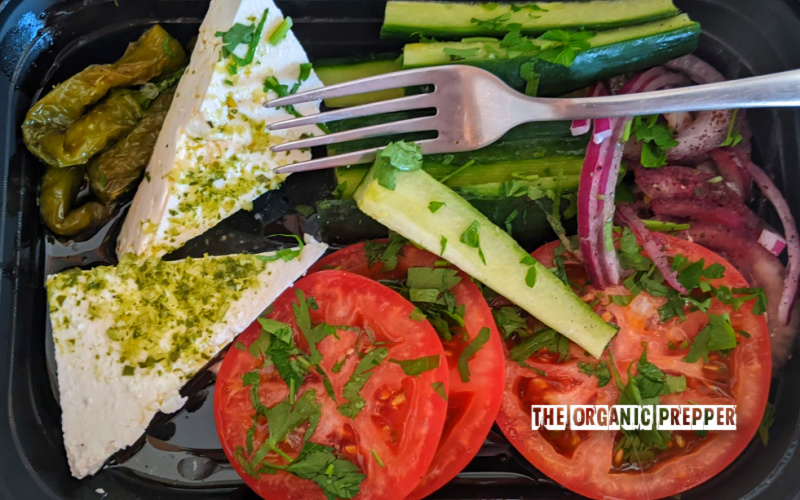
Traditional Food for thought
Over here, you don’t see a lot of vegans and vegetarians. Nobody I’ve encountered eats low-carb or grain-free, or dairy-free. In fact, if you try and order those types of meals in restaurants, they’ll look at you oddly. They’ll nod, and sometimes they’ll try to accommodate you (but not always – there’s a culture of you’ll-get-what-you-get here). I’ve certainly loosened up and simply try to go with the flow and not be too picky.
These things aren’t particularly “foreign” either. They just go back to a time that is largely forgotten in most of the US. This is how our grandparents ate before food became an industrialized product. We, as preppers, are all about the throwbacks – perhaps we need to uncomplicate food and revisit the past.
I hope this missive about traditional food inspires you to look at your diet a little differently if this isn’t how you eat right now. I know that I fully intend to bring home recipes and ideas that I’ve collected, as I’ve done over the years after being influenced by my time in Mexico and other places. Perhaps some of these foods will make their way to your own tables or give you some ideas for your garden goodies.
Do you eat traditional food? What are some of your favorites? How about foods from other countries or cultures? Can you see how you might apply some of this to preparedness? Let’s discuss it in the comments section.
About Daisy
Daisy Luther is a coffee-swigging, adventure-seeking, globe-trotting blogger. She is the founder and publisher of three websites. 1) The Organic Prepper, which is about current events, preparedness, self-reliance, and the pursuit of liberty; 2) The Frugalite, a website with thrifty tips and solutions to help people get a handle on their personal finances without feeling deprived; and 3) PreppersDailyNews.com, an aggregate site where you can find links to all the most important news for those who wish to be prepared. Her work is widely republished across alternative media and she has appeared in many interviews.
Daisy is the best-selling author of 5 traditionally published books, 12 self-published books, and runs a small digital publishing company with PDF guides, printables, and courses at SelfRelianceand Survival.com You can find her on Facebook, Pinterest, Gab, MeWe, Parler, Instagram, and Twitter.
Article cross-posted from The Organic Prepper.
Sound off about this article and follow my Late Prepper Substack.
Five Things New “Preppers” Forget When Getting Ready for Bad Times Ahead
The preparedness community is growing faster than it has in decades. Even during peak times such as Y2K, the economic downturn of 2008, and Covid, the vast majority of Americans made sure they had plenty of toilet paper but didn’t really stockpile anything else.
Things have changed. There’s a growing anxiety in this presidential election year that has prompted more Americans to get prepared for crazy events in the future. Some of it is being driven by fearmongers, but there are valid concerns with the economy, food supply, pharmaceuticals, the energy grid, and mass rioting that have pushed average Americans into “prepper” mode.
There are degrees of preparedness. One does not have to be a full-blown “doomsday prepper” living off-grid in a secure Montana bunker in order to be ahead of the curve. In many ways, preparedness isn’t about being able to perfectly handle every conceivable situation. It’s about being less dependent on government for as long as possible. Those who have proper “preps” will not be waiting for FEMA to distribute emergency supplies to the desperate masses.
Below are five things people new to preparedness (and sometimes even those with experience) often forget as they get ready. All five are common sense notions that do not rely on doomsday in order to be useful. It may be nice to own a tank during the apocalypse but there’s not much you can do with it until things get really crazy. The recommendations below can have places in the lives of average Americans whether doomsday comes or not.
Note: The information provided by this publication or any related communications is for informational purposes only and should not be considered as financial advice. We do not provide personalized investment, financial, or legal advice.
Secured Wealth
Whether in the bank or held in a retirement account, most Americans feel that their life’s savings is relatively secure. At least they did until the last couple of years when de-banking, geopolitical turmoil, and the threat of Central Bank Digital Currencies reared their ugly heads.
It behooves Americans to diversify their holdings. If there’s a triggering event or series of events that cripple the financial systems or devalue the U.S. Dollar, wealth can evaporate quickly. To hedge against potential turmoil, many Americans are looking in two directions: Crypto and physical precious metals.
There are huge advantages to cryptocurrencies, but there are also inherent risks because “virtual” money can become challenging to spend. Add in the push by central banks and governments to regulate or even replace cryptocurrencies with their own versions they control and the risks amplify. There’s nothing wrong with cryptocurrencies today but things can change rapidly.
As for physical precious metals, many Americans pay cash to keep plenty on hand in their safe. Rolling over or transferring retirement accounts into self-directed IRAs is also a popular option, but there are caveats. It can often take weeks or even months to get the gold and silver shipped if the owner chooses to close their account. This is why Genesis Gold Group stands out. Their relationship with the depositories allows for rapid closure and shipping, often in less than 10 days from the time the account holder makes their move. This can come in handy if things appear to be heading south.
Lots of Potable Water
One of the biggest shocks that hit new preppers is understanding how much potable water they need in order to survive. Experts claim one gallon of water per person per day is necessary. Even the most conservative estimates put it at over half-a-gallon. That means that for a family of four, they’ll need around 120 gallons of water to survive for a month if the taps turn off and the stores empty out.
Being near a fresh water source, whether it’s a river, lake, or well, is a best practice among experienced preppers. It’s necessary to have a water filter as well, even if the taps are still working. Many refuse to drink tap water even when there is no emergency. Berkey was our previous favorite but they’re under attack from regulators so the Alexapure systems are solid replacements.
For those in the city or away from fresh water sources, storage is the best option. This can be challenging because proper water storage containers take up a lot of room and are difficult to move if the need arises. For “bug in” situations, having a larger container that stores hundreds or even thousands of gallons is better than stacking 1-5 gallon containers. Unfortunately, they won’t be easily transportable and they can cost a lot to install.
Water is critical. If chaos erupts and water infrastructure is compromised, having a large backup supply can be lifesaving.
Pharmaceuticals and Medical Supplies
There are multiple threats specific to the medical supply chain. With Chinese and Indian imports accounting for over 90% of pharmaceutical ingredients in the United States, deteriorating relations could make it impossible to get the medicines and antibiotics many of us need.
Stocking up many prescription medications can be hard. Doctors generally do not like to prescribe large batches of drugs even if they are shelf-stable for extended periods of time. It is a best practice to ask your doctor if they can prescribe a larger amount. Today, some are sympathetic to concerns about pharmacies running out or becoming inaccessible. Tell them your concerns. It’s worth a shot. The worst they can do is say no.
If your doctor is unwilling to help you stock up on medicines, then Jase Medical is a good alternative. Through telehealth, they can prescribe daily meds or antibiotics that are shipped to your door. As proponents of medical freedom, they empathize with those who want to have enough medical supplies on hand in case things go wrong.
Energy Sources
The vast majority of Americans are locked into the grid. This has proven to be a massive liability when the grid goes down. Unfortunately, there are no inexpensive remedies.
Those living off-grid had to either spend a lot of money or effort (or both) to get their alternative energy sources like solar set up. For those who do not want to go so far, it’s still a best practice to have backup power sources. Diesel generators and portable solar panels are the two most popular, and while they’re not inexpensive they are not out of reach of most Americans who are concerned about being without power for extended periods of time.
Natural gas is another necessity for many, but that’s far more challenging to replace. Having alternatives for heating and cooking that can be powered if gas and electric grids go down is important. Have a backup for items that require power such as manual can openers. If you’re stuck eating canned foods for a while and all you have is an electric opener, you’ll have problems.
Don’t Forget the Protein
When most think about “prepping,” they think about their food supply. More Americans are turning to gardening and homesteading as ways to produce their own food. Others are working with local farmers and ranchers to purchase directly from the sources. This is a good idea whether doomsday comes or not, but it’s particularly important if the food supply chain is broken.
Most grocery stores have about one to two weeks worth of food, as do most American households. Grocers rely heavily on truckers to receive their ongoing shipments. In a crisis, the current process can fail. It behooves Americans for multiple reasons to localize their food purchases as much as possible.
Long-term storage is another popular option. Canned foods, MREs, and freeze dried meals are selling out quickly even as prices rise. But one component that is conspicuously absent in shelf-stable food is high-quality protein. Most survival food companies offer low quality “protein buckets” or cans of meat, but they are often barely edible.
Prepper All-Naturals offers premium cuts of steak that have been cooked sous vide and freeze dried to give them a 25-year shelf life. They offer Ribeye, NY Strip, and Tenderloin among others.
Having buckets of beans and rice is a good start, but keeping a solid supply of high-quality protein isn’t just healthier. It can help a family maintain normalcy through crises.
Prepare Without Fear
With all the challenges we face as Americans today, it can be emotionally draining. Citizens are scared and there’s nothing irrational about their concerns. Being prepared and making lifestyle changes to secure necessities can go a long way toward overcoming the fears that plague us. We should hope and pray for the best but prepare for the worst. And if the worst does come, then knowing we did what we could to be ready for it will help us face those challenges with confidence.

